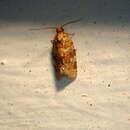Conservation Status
provided by University of Alberta Museums
Not of concern but rare in Alberta.
- license
- cc-by-nc
- copyright
- University of Alberta Museums
Cyclicity
provided by University of Alberta Museums
Late April to early June (Freeman 1958).
- license
- cc-by-nc
- copyright
- University of Alberta Museums
Distribution
provided by University of Alberta Museums
From British Columbia to Nova Scotia, south in the east to Florida, in Alberta it is sporadically encountered in the boreal.
- license
- cc-by-nc
- copyright
- University of Alberta Museums
General Description
provided by University of Alberta Museums
"The forewing is shiny light yellow with some brown reticulation. Broad brown bands that slant towards the anal angle dominate the wing in the basal, median, and upper postmedian areas. The head and thorax are brown while the abdomen and hindwings are medium grey.
The larva is dull yellow with slightly darker brownish yellow thoracic shield and head."
- license
- cc-by-nc
- copyright
- University of Alberta Museums
Habitat
provided by University of Alberta Museums
Coniferous and mixed forest.
- license
- cc-by-nc
- copyright
- University of Alberta Museums
Life Cycle
provided by University of Alberta Museums
The solitary larva starts as a needle miner in early instars (MacKay 1962). In later instars they live inside a tube made form several needles tied together, gradually feeding on the end of it. As tubes get short from larval feeding, they are abandoned to construct newer ones which are also where pupation occurs (Forbes 1923).
- license
- cc-by-nc
- copyright
- University of Alberta Museums
Trophic Strategy
provided by University of Alberta Museums
The larva is found most commonly on White Pine (Pinus strobus) in eastern Canada, it is rarer in the west on other species of pine.
- license
- cc-by-nc
- copyright
- University of Alberta Museums

